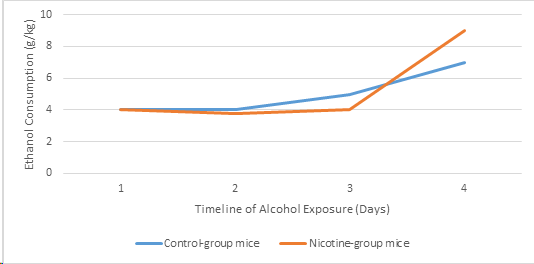It can be difficult to predict why some adolescents engage in certain substance abuse behaviors, and others do not. Similarly, we have a hard time predicting which adolescents will continue using drugs such as nicotine and alcohol through adulthood and which will age out. Adolescent smokers seem to be more likely than non-smokers to experiment with alcohol (Best et al., 2000), but it is unclear what mechanism drives this association. In addition, teen girls are more likely to smoke cigarettes than teen boys (Pogun & Yararbas, 2009); which in turn, according to the current study, may put girls at a higher risk of binge drinking. This week, ASHES reviews a study that examined how early nicotine exposure might impact binge drinking and developmental changes in the brains of female adolescent mice (Locker et al, 2015).
Methods
- The researchers used 26 female adolescent mice in a laboratory setting.
- For the first seven days of the experiment, mice received one of two conditions:
- In the Nicotine condition, they had access to nicotine dissolved in water for most of the day.
- In the Control condition, they had access only to tap water.
- Then, for 4 days, the nicotine/water exposure continued as usual, but for the 2-4 hours when the mice were most likely to ingest food or drink, the researchers gave both groups of mice access to alcohol (ethanol). This was meant to simulate the opportunity to binge drink.
- The researchers measured how much ethanol the mice consumed and how it affected their Blood Ethanol Concentration (BEC). They were curious about whether the mice exposed to nicotine would consume more alcohol than mice exposed to water.
- In addition, for the nicotine group, the researchers looked at the amount of nicotine that mice consumed after exposure to alcohol compared to before.
- Researchers also studied Nicotinic Acetylcholine Receptors (nAChRs) in the brain using two techniques[1].
- nAChRs are important because they are the molecular foundation of nicotine addiction. They respond to nicotine and trigger system-wide changes, impacting how we behave and feel.
Results
- Mice in the nicotine group consumed more alcohol on the last day of exposure and had a higher BEC when compared to the control group. (See Figures 1 and 2.)
- Mice in the nicotine group also consumed significantly more nicotine after the exposure to alcohol than before, suggesting that exposure to either drug can increase the use of the other.
- Mice in the nicotine group had a higher density and concentration of Nicotinic Acetylcholine Receptors (nAChRs) in the cortex than the control group.
Figures
Figure 1. Mice in the Nicotine group consumed more alcohol than the Control Group on the final day of access to alcohol. Day 4 showed the only statistically significant difference between groups. Adapted from Locker et al. (2015).
Figure 2. Mice in the Nicotine group had a higher blood ethanol content (BEC). Adapted from Locker et al. (2015).
Limitations
- The sample only included female mice.
- All mice were exposed to ethanol during the course of the study. It would be interesting to observe the natural course of addiction-related changes among the mice exposed to nicotine in the absence of ethanol, both on the behavioral and brain levels.
- Ethanol and nicotine exposure were kept separate. There was no examination of the co-use of nicotine and ethanol administered simultaneously.
Conclusion
The current study suggests that early exposure to drugs like nicotine may impact the way teenage girls interact with alcohol. Mice that were exposed to nicotine consumed more alcohol than mice who were not. The researchers also found a higher concentration of Nicotinic Acetylcholine Receptors in the mice exposed to Nicotine. The enhancement, or priming of these receptors may affect way adolescents behave and make decisions and might set the stage for future expressions of addiction, even beyond smoking. To test this, in future research, researchers could study the association between the density and concentration of Nicotinic Acetylcholine Receptors and binge drinking.
— Alec Conte
What do you think? Please use the comment link below to provide feedback on this article.
References
Best, D., et al (2000). Drinking and smoking as concurrent predictors of illicit drug use and positive drug attitudes in adolescents. Drug Alcohol Dependence, 60, 319-321.
Locker, A.R., et al. (2015). Exposure to Nicotine increases nicotinic acetylcholine receptor density in the reward pathway and binge ethanol consumption in C57BL/6j female mice. Brain Research Bulletin. http://dx.doi.org/10.1016/j.brainresbull.2015.09.009
Pogun, S., & Yararbas, G. (2009). Sex differences in nicotine action. Handbook of Experimental Pharmacology, 192, 291.
[1] 1. Autoradiography: An imaging that allows the researchers to examine receptor density in areas of the brain called: Receptor Autoradiography.
2. Epibatinide Binding: Chemically treating the brain receptors with a substance called Epibatidine which is known to bind particularly well with nAChRs.






